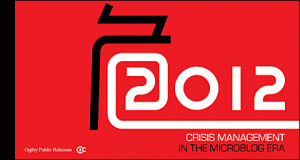 Shanghai: CIC and Ogilvy Public Relations, China have teamed up again to jointly launch the white paper, “2012 Crisis Management in the Microblog Era,” which analyzed 50 Chinese brand crises in 2012 – concluding that brands which respond within the first 8 hours of a crisis’ outbreak are more effective at controlling it, shortening its duration and lowering the overall level of negative buzz. The report also ranks China’s top 10 crises in the public credibility, personal and brand categories in 2012.
Shanghai: CIC and Ogilvy Public Relations, China have teamed up again to jointly launch the white paper, “2012 Crisis Management in the Microblog Era,” which analyzed 50 Chinese brand crises in 2012 – concluding that brands which respond within the first 8 hours of a crisis’ outbreak are more effective at controlling it, shortening its duration and lowering the overall level of negative buzz. The report also ranks China’s top 10 crises in the public credibility, personal and brand categories in 2012.
According to this year’s ranking, eight out of the top 10 crises on microblogs and in traditional media were the same. In the public credibility category, more than half of the crises were related to public officials as microblogs now play a role of ever-growing importance in tackling corruption due to its openness, efficiency and convenience in communications. According to the top 10 personal crises ranking, Weibo, or Chinese microblogs, is a two-sided coin that can amplify personal influence or destroy an individual’s reputation and ffiliated organization. Eight out of the 10 brand crises were food safety related as Chinese netizens continue to lack confidence in the state of China’s food safety, rendering this an extremely sensitive topic. A single brand’s crisis can easily affect its entire industry. With negative news able to spread at such high speed on microblogs, brand crises can now escalate faster than ever before.
Debby Cheung, President of Ogilvy & Mather Group, Shanghai and Managing Director of Ogilvy PR, China, said, “Knowledge and preparation in online crisis management are necessary for corporate communications departments in the microblog era. It became clear in 2012 that microblogs are now the main platform for disseminating news and guiding public opinion. How far a crisis spread and how long it lingered on microblogs determined the crisis’ severity. If the news isn’t on Chinese microblogs, then it hasn’t reached crisis level yet.”
Key Findings
The “2012 Crisis Management in the Microblog Era” white paper is a statistical analysis of 50 Chinese brand crises from 2012, based on an evaluation of each crisis according to key elements of crisis management in the microblog era. The key takeaways are as follow:
The shorter the response time, the better
If a brand responds within 8 hours, the crisis duration and negative buzz will be the lowest. Responding within 24 hours will shorten the crisis duration and minimize negative influence. If the first response time is more than 24 hours after a crisis outbreak, then there will be an obvious extension of the crisis duration. It is crucial to have a crisis management system in place ahead of the crisis and prepare for different scenarios to respond effectively and efficiently to curb the spread of negative buzz at the outbreak of a crisis.
It works best when senior executives respond directly
When the suitability of the response tone increases by 1 percent, the proportion of negative buzz decreases by 0.5 percent. A direct response from high level executives is more effective than a response from low level employees. Now that microblogs have become a major communications platform for corporate spokespeople, relevant trainings need to be offered to them. A company’s crisis management system should be standardized and apply to all staff to prevent individual employee misconduct at the time of a crisis response and avoid causing more harm.
Using an official microblog account can help manage a crisis
Brands that had active official microblog accounts before the crisis were able to reduce the response time by around 12 hours, decrease the crisis duration by an average of 2 days and reduce the proportion of negative buzz. Brands should set up an official microblog account as early as possible, and integrate all of their owned social media resources into their crisis management systems, as a quick and effective response requires a nimble and local structure.
CIC CEO Daisy Zhang, said, “In 2012, crises in the microblog era contained similar trends as those in 2011, including the communication speed, channels, tones, and feedback, while new characteristics have also emerged. We chose 50 brand crises based on how much buzz it created on microblogs as trending topics and conducted an inductive analysis of them. We hope the business implications offered in this report will help companies to better manage crises on microblogs with flexibility.”
Comments are closed.